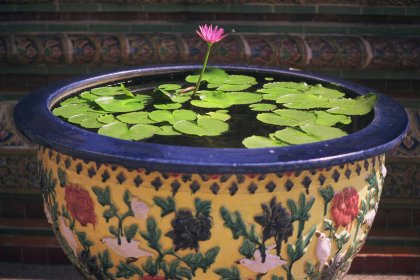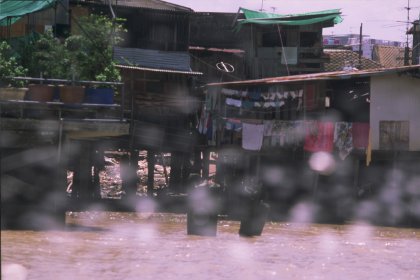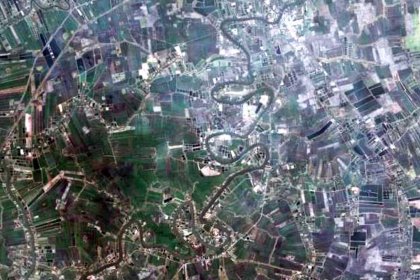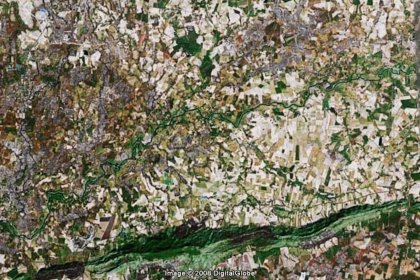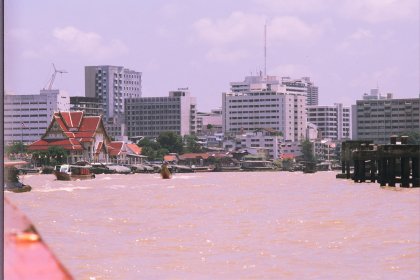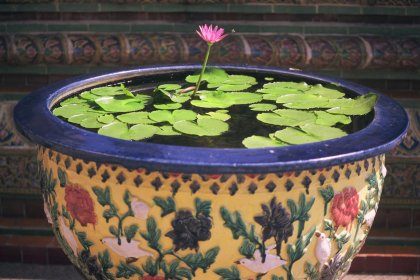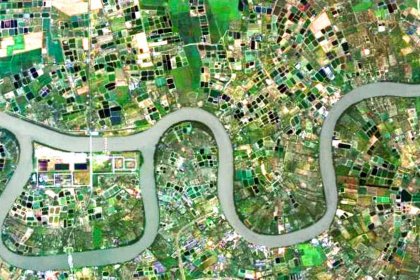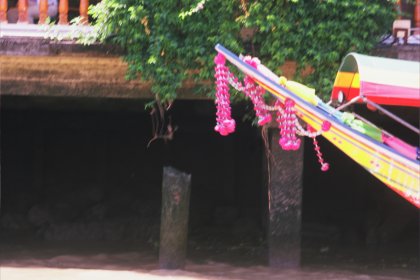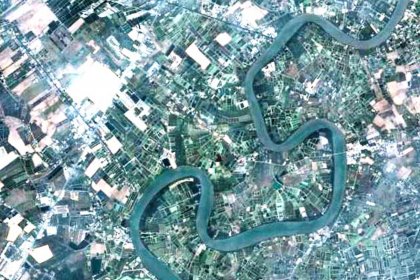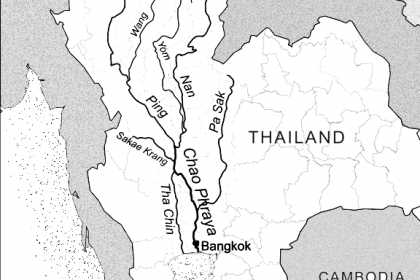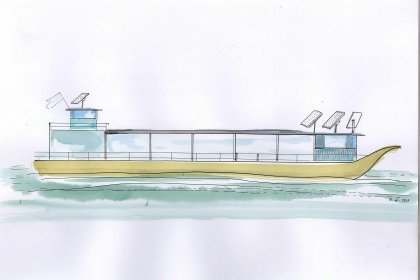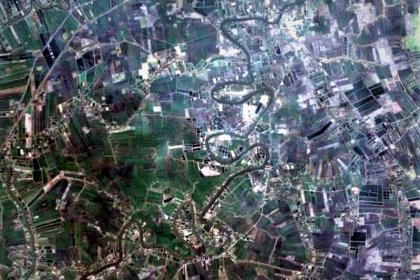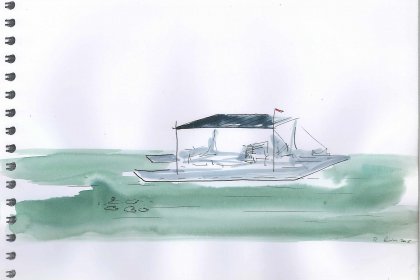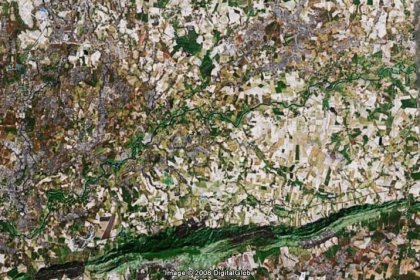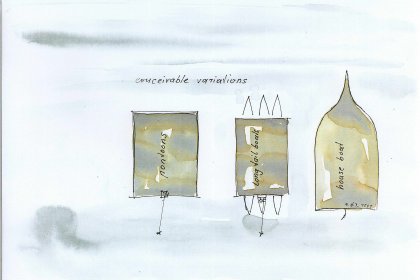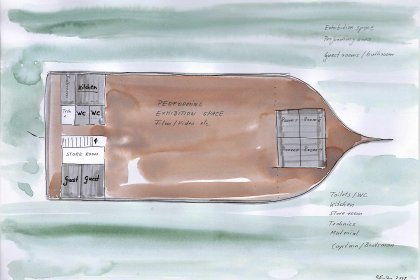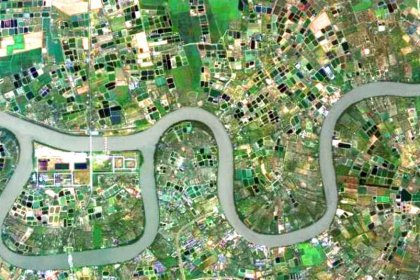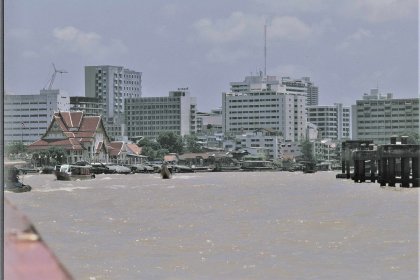Chao Phraya River Raft 2004 /2008
Performance-art platform
The Menam Chao Phraya River Raft
Introduction
Water has a special meaning for Thailand and for the people who are living in the area of South East Asia. There is not only the tradition of wet rice agriculture and fishing. The rivers have been important for developing trade and transportation between the cities.
The Menam Chao Phraya is the river of the Kings and the Mother of all waters in Thailand. The people along the Chao Phraya river Basin developed their own strategies to survive floods and dry periods. They live in a special area and many are still depended on the river. But even if it is so important for agriculture and the support of drinking water it has like all big rivers in the world to carry all the pollution of civilisation and industrial production. So it is also an example for near all kinds of ecological mistakes and crimes against the environment of modern times.
This project is a homage to the elements of nature, but equal a dedication to simple life and the poor people of Thailand.
The idea is, to create a flexible permanent platform for activities for the people along the river areas. It should be a swimming object/ platform which is able to be pulled, or drive itself, upstream the Chao Phraya River as long as it is navigable.
Concept
The project works with the intention of a laboratory in the sense of a working space / platform for experiments of all kinds of cultural, ecological and social activities. This includes scientific work, ecological research, art events / exhibitions, performance, film etc. up to social projects like EMPOWER, information events about aids etc. In the end, the project might be a pool for open minded, critical visions and projects including performances and entertainment.
The program should be developed by a changing team of local and international guest curators, in cooperation with the local people of the rural areas or the inhabitants of the cities along the river. It should give also young people the opportunity and the chance to participate, create their own visions, and join international and global structures and contacts beyond the Internet.
In summary the Chao Phraya River Raft will be an Art-Project. The big frame of art gives the most open possibilities and allows all kind of activities. This might be traditional art forms of painting, shadow puppets etc. up to future labs for visions. They all might be articulated on this platform.
The project itself should be developed in several steps.
set up an organisation team
develop and modify the concept
set up a time frame
searching for structures who are interested in cooperation or /and sponsoring
clearing official permits, papers etc.
press / media work
building the object
planning and modify the first events
Who is involved?
First of all the project is a ‘platform’ for the Thai society. Scientist, artists, philosophers, social workers and other kinds of creative resources should be involved and work interdisciplinary together. Further the extension of an international exchange and joint ventures is part of the concept.
In the beginning, it might make sense to involve artists and others who have an international reputation. They may invite artists and other institutions from all over the world.
An independent curator team or any other kind of structure might organize the activities and programs.
The project should be supported by
• The knowledge and the influence of Thai Universities and Social Institutions like: Silpakorn University, Chulalongkorn University, (faculties of science and technology) Faculty of Fine Arts) KMITL (Research) Concrete House and others..
• International Culture Institutes and foundations like: The British Council, Goethe Institute, Alliance Francaise, the Heinrich Böll Foundation, Austrian Embassy, Intercultural institute of Japan etc. All countries who have an interest in exchange among Thai and their own economy and culture like China, Canada, Australia or the USA should be invited to join and support the project. This might be logistic, financial, or political resources.
• Thailand Environment Institute / Department of Agriculture of Thailand
• The Unesco / World water assessment programme
How does it work?
There should be a structure who has to discuss and to continue the developing of the concept. Also it has to organize the first financial support.
It makes sense to have a team of people who are organizing the contacts, permissions, staff, hardware, materials etc. and a second team who are developing and curating the program.
It is important to find a patronage for the project. There are certain possibilities to keep the interdisciplinary and global concept. One would be, if the UN is able to adapt the concept, but it should be also verified if other institutions and organisations are able and willing to share. Further it should be proofed if there is a way to get the interest of the Royal Family of Thailand.
King Bhumibol is famous for his social and environmental engagement. In case that the royal family takes the patronage of the laboratory, the question has to be considered, if the freedom of the concept does not create any conflict with the royal traditions and feelings.
Time frames
The project will be limited in time to give all participants the chance, to overview the planed engagement for the project. The plan is to move the river upstream and come back to the sea. This might last one year. If the concept is working well, and there is still interest, money and people who like to continue the project, this should be possible.
Another option might be if the Unesco or others would be willing to support a long lasting research.
The hardware
Probably the most difficult part to put into practise might be to get permission for the project from the military government. Parts of the river area – especially in BKK – stay under the interest of the militaries and the royal family.
The object itself might be an old cargo ship or three long-tail-boats assembled together. But it could be also pontoons fixed together to a platform or any other construction. (I did in Austria) The main part of the Performance Space platform will be a wide-spread exhibition and performing space. The platform needs a roof /shelter and some little rooms for facilities (see sketches). Further for one or two persons who organize the programs and take care of the space should be the possibility to live on the platform. Also there should be –at least- two guestrooms for artists and others. This will be depended on the financial resources, permissions and other things. During the stay in rural areas all materials, food etc. should be bought as far as possible at the local farmers, shops etc.
The staff
Beside the curator team or the art director the laboratory will need a little team of people who run the program, take care of the visitors, maintain the contacts and feel responsible for the Space. This might be a kind of long time volunteer job, or a student group under the patronage of a university, which should be paid good enough, that there is no need for a further job during this time. Further it will be a person needed who is allowed and able to move and ship the laboratory on the river, from one town to the next village and next town etc...
Perhaps this has not to be a permanent job (if the object is anchored for longer time on a place )

